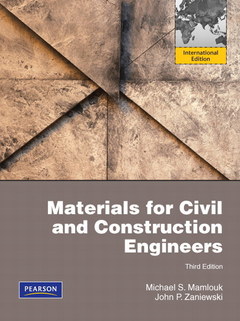Description
Materials for civil and construction engineers (3rd ed )
Authors: MAMLOUK Michael S., ZANIEWSKI John P.
Language: English
Approximative price 96.04 €
In Print (Delivery period: 12 days).
Add to cart600 p. · 17.8x23.2 cm · Paperback
Description
/li>Contents
/li>
Materials for Civil and Construction Engineers, 3/e is ideal for courses in Civil Engineering Materials, Construction Materials, and Construction Methods and Materials offered in Civil, Environmental, or Construction engineering departments.
This introduction gives students a basic understanding of the material selection process and the behavior of materials - a fundamental requirement for all civil and construction engineers performing design, construction, and maintenance. The authors cover the various materials used by civil and construction engineers in one useful reference, limiting the vast amount of information available to the introductory level, concentrating on current practices, and extracting information that is relevant to the general education of civil and construction engineers. A large number of experiments, figures, sample problems, test methods, and homework problems gives students opportunity for practice and review.
Preface xiv
ONE Materials Engineering Concepts 1
1.1 Economic Factors 2
1.2 Mechanical Properties 3
1.2.1 Loading Conditions 4
1.2.2 Stress Strain Relations 5
1.2.3 Elastic Behavior 5
1.2.4 Elastoplastic Behavior 8
1.2.5 Viscoelastic Behavior 12
1.2.6 Temperature and Time Effects 17
1.2.7 Work and Energy 18
1.2.8 Failure and Safety 18
1.3 Nonmechanical Properties 21
1.3.1 Density and Unit Weight 21
1.3.2 Thermal Expansion 22
1.3.3 Surface Characteristics 23
1.4 Production and Construction 24
1.5 Aesthetic Characteristics 25
1.6 Sustainable Design 26
1.7 Material Variability 27
1.7.1 Sampling 28
1.7.2 Normal Distribution 29
1.7.3 Control Charts 29
1.7.4 Experimental Error 32
1.8 Laboratory Measuring Devices 32
1.8.1 Dial Gauge 33
1.8.2 Linear Variable Differential Transformer (LVDT) 33
1.8.3 Strain Gauge 37
1.8.4 Non-Contact Deformation Measurement Technique 38
1.8.5 Proving Ring 38
1.8.6 Load Cell 39
Summary 40
Questions and Problems 41
1.9 References 51
TWO Nature of Materials 52
2.1 Basic Materials Concepts 52
2.1.1 Electron Configuration 52
2.1.2 Bonding 55
2.1.3 Material Classification by Bond Type 58
2.2 Metallic Materials 58
2.2.1 Lattice Structure 59
2.2.2 Lattice Defects 63
2.2.3 Grain Structure 64
2.2.4 Alloys 67
2.2.5 Phase Diagrams 67
2.2.6 Combined Effects 73
2.3 Inorganic Solids 73
2.4 Organic Solids 75
2.4.1 Polymer Development, Structure, and Cross-Linking 76
2.4.2 Melting and Glass Transition Temperature 79
2.4.3 Mechanical Properties 80
Summary 81
Questions and Problems 81
2.5 References 84
THREE Steel 85
3.1 Steel Production 87
3.2 Iron Carbon Phase Diagram 89
3.3 Heat Treatment of Steel 93
3.3.1 Annealing 93
3.3.2 Normalizing 94
3.3.3 Hardening 95
3.3.4 Tempering 95
3.3.5 Example of Heat Treatment 95
3.4 Steel Alloys 95
3.5 Structural Steel 97
3.5.1 Structural Steel Grades 97
3.5.2 Sectional Shapes 100
3.5.3 Specialty Steels in Structural Applications 101
3.6 Cold-Formed Steel 106
3.6.1 Cold-Formed Steel Grades 106
3.6.2 Cold-Formed Steel Shapes 107
3.6.3 Special Design Considerations for Cold-Formed Steel 109
3.7 Fastening Products 109
3.8 Reinforcing Steel 111
3.8.1 Conventional Reinforcing 111
3.8.2 Steel for Prestressed Concrete 115
3.9 Mechanical Testing of Steel 116
3.9.1 Tension Test 116
3.9.2 Torsion Test 119
3.9.3 Charpy V Notch Impact Test 122
3.9.4 Bend Test 124
3.9.5 Hardness Test 125
3.9.6 Ultrasonic Testing 125
3.10 Welding 126
3.11 Steel Corrosion 129
3.11.1 Methods for Corrosion Resistance 130
Summary 131
Questions and Problems 131
3.12 References 139
FOUR Aluminum 140
4.1 Aluminum Production 143
4.2 Aluminum Metallurgy 145
4.2.1 Alloy Designation System 147
4.2.2 Temper Treatments 148
4.3 Aluminum Testing and Properties 151
4.4 Welding and Fastening 156
4.5 Corrosion 157
Summary 157
Questions and Problems 157
4.6 References 162
FIVE Aggregates 163
5.1 Aggregate Sources 164
5.2 Geological Classification 165
5.3 Evaluation of Aggregate Sources 165
5.4 Aggregate Uses 166
5.5 Aggregate Properties 167
5.5.1 Particle Shape and Surface Texture 169
5.5.2 Soundness and Durability 171
5.5.3 Toughness, Hardness, and Abrasion Resistance 172
5.5.4 Absorption 173
5.5.5 Specific Gravity 175
5.5.6 Bulk Unit Weight and Voids in Aggregate 177
5.5.7 Str




